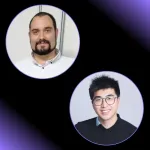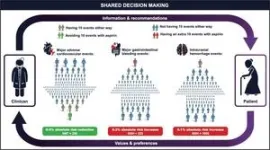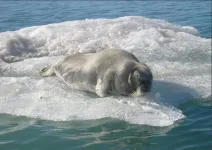(Press-News.org) USD$200,000 awarded to tackle today’s pressing consumer technology demands
Utilizing smart optical sensors for IoT
Providing more realistic virtual and augmented realities
WASHINGTON – The Optica Foundation today released more detailed information on information technology research funded by the 2023 Optica Foundation Challenge. Researchers Zaijun Chen, University of Southern California, USA, and Alejandro Velez-Zea, Universidad de Antioquia, Colombia, both proposed novel approaches to addressing the flow of data and information in consumer-centric technologies.
“The growing use of ‘smart’ consumer technologies and augmented and virtual reality is simultaneously maxing out bandwidth and driving a desire for better experiences,” said Ulrike Woggon, member of the Challenge Selection Committee. “Drs. Chen and Velez-Zea are introducing unique, innovative ways to address these issues by lessening the network burden and creating more seamless interactions and realistic environments.”
Both of the research efforts are supported by a USD$100,000 grant from the Optica Foundation, and Chen and Velez-Zea will use these funds to advance their work in the following ways:
Smart optical sensors for IoT
Zaijun Chen, University of Southern California, USA
Accelerating optical edge sensing with photonic deep learning
Research Executive Summary
Worldwide spending on the Internet of Things (IoT) is forecasted to reach USD$806 billion this year, an increase of 10.6% over 2022, with a compound annual growth rate (CAGR) of 10.4% through 2027. These robust increases translate to network demand, and existing optical sensing networks demonstrate large energy consumption, data traffic, and long latency that create stopgaps for new requirements.
Now, work from Zaijun Chen, University of Southern California, USA, points to the promise of smart optical sensors that combine optical neural network processors with optical sensing for a more efficient solution. In today’s existing process, optical signals need to be converted to the electrical domain as part of the flow of information. Chen proposes a novel, smart optical sensor that can detect and process optical signals without the need for conversion, thus reducing energy consumption, latency, data traffic, and sensor footprint by orders of magnitude.
“This is a new field of study,” shared Chen. “We are trying to sense and combine optics and electronics with optical machine learning to process information more effectively and efficiently. It’s a unique approach to an existing problem.”
In three months, Chen expects to have a prototype of the first smart sensing device ready for testing, and from there, will begin training it on machine learning models that speak to specific IoT needs.
More realistic holography for AR/VR
Alejandro Velez-Zea, Universidad de Antioquia, Colombia
Multilayer holographic augmented reality with digital micromirror devices: content pipeline and system implementation
Research Executive Summary
The augmented reality/virtual reality (AR/VR) landscape has seen a rapid rise—standalone headsets have had a compound annual growth rate (CAGR) of 57.5% and by 2027, the market is expected to reach 30.3 million units globally. But as these products proliferate, their users become more sophisticated and strive for more realistic experiences, pushing technological advances.
Research from Alejandro Velez-Zea, Universidad de Antioquia, Colombia, seeks to deliver on that demand. Today, virtual reality headsets are primarily based on two flat images that give the impression of 3D, but the brain knows it’s not truly an immersive experience. By applying an array of mirrors that can rotate at very high speeds to change the direction of incoming light, Velez-Zea proposes a more comprehensive, authentic experience. Using digital micromirror devices (DMD), Velez-Zea and his team will create a modern AR/VR environment that is less costly than existing offerings.
“I’m very passionate about the next revolution in AR/VR technology and how we present information using light to show the real world,” shared Velez-Zea. “Our goal is to enable a new generation of much more affordable augmented reality solutions.”
Velez-Zea intends to develop a prototype system to demonstrate the capabilities of holographic augmented reality, but that work starts with testing algorithms to improve the limitations of DMDs. In six months, he and his team hope to finalize a prototype design and then focus on ways to optimize the experience and shrink the device’s size for easier portability.
These research initiatives were made possible through the Optica Foundation Challenge grants. This challenge was designed to engage early-career professionals in out-of-the-box thinking and provide seed money to investigate hypotheses in the areas of environment, health and information. Each recipient received USD$100,000 to explore their ideas and take steps toward addressing critical global issues. Recipients have begun working on these projects and expect to report initial results in 2024. For more information, visit optica.org/Challenge.
Optica Foundation
Established in 2002, the Optica Foundation carries out charitable activities in support of the society’s student and early career members. We cultivate the next generation of leaders and innovators as they navigate advanced degree programs and become active members of research, engineering and business communities worldwide. The foundation also works to secure the endowments for Optica’s awards and honors programs. The foundation is registered as a 501(c)(3) non-profit. For more information, visit optica.org/foundation.
About Optica
Optica (formerly OSA), Advancing Optics and Photonics Worldwide, is the society dedicated to promoting the generation, application, archiving and dissemination of knowledge in the field. Founded in 1916, it is the leading organization for scientists, engineers, business professionals, students and others interested in the science of light. Optica’s renowned publications, meetings, online resources and in-person activities fuel discoveries, shape real-life applications and accelerate scientific, technical and educational achievement. Discover more at: Optica.org
Media Contact
mediarelations@optica.org
Colleen Morrison, CFM Communications, colleen@cfm-communications.com
END
Photonics research reveals potential for next-gen AR/VR and IoT
Optica Foundation Challenge empowers research teams to find solutions for today’s emerging technology problems
2023-12-14
ELSE PRESS RELEASES FROM THIS DATE:
Jurors recommend death penalty based on looks, but new training can correct the bias
2023-12-14
Certain facial features—like downturned lips and a heavy brow—are known to make someone appear untrustworthy to others, even though these do not indicate a person’s actual character. Such facial biases influence our everyday social interactions as well as high-stakes decisions, including who we hire, or elect to political office.
But a new study by Columbia researchers shows that the effects of these judgments can be mitigated. The study outlines the results of four experiments that the authors conducted with 1,400 volunteers. Through those experiments, the researchers found that when real-world defendants have facial features that appear untrustworthy, they are more likely ...
Closing the design-to-manufacturing gap for optical devices
2023-12-14
Photolithography involves manipulating light to precisely etch features onto a surface, and is commonly used to fabricate computer chips and optical devices like lenses. But tiny deviations during the manufacturing process often cause these devices to fall short of their designers’ intentions.
To help close this design-to-manufacturing gap, researchers from MIT and the Chinese University of Hong Kong used machine learning to build a digital simulator that mimics a specific photolithography manufacturing process. Their technique utilizes real data gathered from the photolithography system, so it can more ...
Seals stay warm and hydrated in the arctic with larger, more convoluted nasal passages
2023-12-14
Arctic seals have evolved many adaptations to cope with their frosty environment—one that you might not immediately think of is the bones in their nasal cavity. Arctic seals have more convoluted nasal passages than seal species that live in milder environments, and researchers report December 14 in the Biophysical Journal that these structures help the seals more efficiently retain heat and moisture as they breathe in and out.
“Thanks to this elaborate structure in their nasal cavities, Arctic seals lose less heat through nasal heat exchange than subtropical seals when both are exposed to the same ...
D-mannose reduces age-triggered changes in urinary tract that increase susceptibility to UTIs
2023-12-14
Aging poses a number of challenges to the body’s well-being, one of the most important being an increased susceptibility to multiple diseases, including urinary tract infections (UTIs). The connection between aging and more prevalent UTIs is not well understood, but now researchers at Baylor College of Medicine have found an explanation.
The researchers show in the journal Developmental Cell that, compared to the younger counterpart, the aging urinary tract in animal models changes how it functions at the cellular level in ways that seem to favor the establishment ...
Where patients live impacts whether they pick up their heart-failure medications
2023-12-14
People who live in neighborhoods with higher levels of poverty and unemployment are less likely to fill their heart-failure drug prescriptions than those living in wealthier areas, a new study shows. The findings not only add to understanding geographic and economic disparities in heart disease care, but also point to new ways to address barriers for patients taking these lifesaving drugs.
Led by researchers at NYU Grossman School of Medicine, the study explored prescription pickup patterns among patients with systolic heart failure, a chronic, life-threatening ...
Animal behavior: Cats like to fetch when they’re feline playful
2023-12-14
Cats tend to dictate games of fetch with their owners and most cats who play fetch learned to do so without explicit training, according to a survey of 924 cat owners published in Scientific Reports. The findings also highlight the variety of objects that cats prefer to fetch, including hair ties and bottle parts.
Jemma Forman, Elizabeth Renner and David Leavens surveyed cat owners who reported fetching behaviours in 1,154 cats that they currently or previously owned. Owners reported how fetching first occurred, how often it occurs ...
New understanding of ancient genetic parasite may spur medical breakthroughs
2023-12-14
A multidisciplinary study published in Nature has elucidated the structure of the machinery responsible for writing much of our “dark genome” — the 98 percent of our DNA that has largely unknown biological function. These results may spur entirely novel treatments for autoimmune diseases, cancer and neurodegeneration.
An international team of scientists from Rutgers and more than a dozen other institutions, including both academia and industry, have published the first high-resolution images and structural details of avirus-like element known as LINE-1. They describe it as “an ancient genetic parasite” that is one of the most common parts of human DNA (video ...
Neighborhood-level socioeconomic status and prescription fill patterns among patients with heart failure
2023-12-14
About The Study: In this study of 6,247 patients with heart failure with reduced ejection fraction, patients living in neighborhoods with lower neighborhood-level socioeconomic status had significantly higher odds of nonadherence to guideline-directed medical therapy. These findings highlight the importance of considering neighborhood-level disparities when developing approaches to improve medication adherence.
Authors: Amrita Mukhopadhyay, M.D., of the NYU Grossman School of Medicine in New York, is the corresponding ...
Sleep disturbances and emotional and behavioral difficulties among preschool-aged children
2023-12-14
About The Study: The natural history of sleep disturbances was associated with both resolved and incident emotional and behavioral difficulties in this study of 17,000 preschool-aged children. Routine screening and precise intervention for sleep disturbances may benefit the psychosocial well-being of this population.
Authors: Fan Jiang, M.D., Ph.D., and Guanghai Wang, Ph.D., of Shanghai Jiao Tong University in Shanghai, are the corresponding authors.
To access the embargoed study: Visit our For The Media ...
Clinical trial shows efficacy for atezolizumab combined with carboplatin
2023-12-14
Immunotherapy in combination with chemotherapy has become an important therapeutic treatment option in some patients with metastatic breast cancer. Which patients will benefit the most, however, remains unclear; current biomarkers such as PD-L1 that are used to predict response are mediocre at best. Vanderbilt researchers led a clinical trial combining atezolizumab, an immunotherapy, in combination with chemotherapy in patients with metastatic triple-negative breast cancer to both evaluate the efficacy of the treatment combination and to understand biomarkers of response ...
LAST 30 PRESS RELEASES:
UVA’s Jundong Li wins ICDM’S 2025 Tao Li Award for data mining, machine learning
UVA’s low-power, high-performance computer power player Mircea Stan earns National Academy of Inventors fellowship
Not playing by the rules: USU researcher explores filamentous algae dynamics in rivers
Do our body clocks influence our risk of dementia?
Anthropologists offer new evidence of bipedalism in long-debated fossil discovery
Safer receipt paper from wood
Dosage-sensitive genes suggest no whole-genome duplications in ancestral angiosperm
First ancient human herpesvirus genomes document their deep history with humans
Why Some Bacteria Survive Antibiotics and How to Stop Them - New study reveals that bacteria can survive antibiotic treatment through two fundamentally different “shutdown modes”
UCLA study links scar healing to dangerous placenta condition
CHANGE-seq-BE finds off-target changes in the genome from base editors
The Journal of Nuclear Medicine Ahead-of-Print Tip Sheet: January 2, 2026
Delayed or absent first dose of measles, mumps, and rubella vaccination
Trends in US preterm birth rates by household income and race and ethnicity
Study identifies potential biomarker linked to progression and brain inflammation in multiple sclerosis
Many mothers in Norway do not show up for postnatal check-ups
Researchers want to find out why quick clay is so unstable
Superradiant spins show teamwork at the quantum scale
Cleveland Clinic Research links tumor bacteria to immunotherapy resistance in head and neck cancer
First Editorial of 2026: Resisting AI slop
Joint ground- and space-based observations reveal Saturn-mass rogue planet
Inheritable genetic variant offers protection against blood cancer risk and progression
Pigs settled Pacific islands alongside early human voyagers
A Coral reef’s daily pulse reshapes microbes in surrounding waters
EAST Tokamak experiments exceed plasma density limit, offering new approach to fusion ignition
Groundbreaking discovery reveals Africa’s oldest cremation pyre and complex ritual practices
First breathing ‘lung-on-chip’ developed using genetically identical cells
How people moved pigs across the Pacific
Interaction of climate change and human activity and its impact on plant diversity in Qinghai-Tibet plateau
From addressing uncertainty to national strategy: an interpretation of Professor Lim Siong Guan’s views
[Press-News.org] Photonics research reveals potential for next-gen AR/VR and IoTOptica Foundation Challenge empowers research teams to find solutions for today’s emerging technology problems


